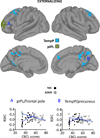Dimensional brain-behavior relationships in children with attention-deficit/hyperactivity disorder
- PMID: 21974788
- PMCID: PMC3568534
- DOI: 10.1016/j.biopsych.2011.08.013
Dimensional brain-behavior relationships in children with attention-deficit/hyperactivity disorder
Abstract
Background: Emerging neuroscientific and genetic findings emphasize the dimensional rather than the categorical aspects of psychiatric disorders. However, the integration of dimensional approaches within the current categorical diagnostic framework remains unclear. Here, we used resting state functional magnetic resonance imaging to examine whether dimensional measures of psychiatric symptomatology capture brain-behavior relationships unaccounted for by categorical diagnoses. Additionally, we examined whether dimensional brain-behavior relationships are modified by the presence of a categorically defined illness, attention-deficit/hyperactivity disorder (ADHD).
Methods: Resting state functional magnetic resonance imaging scans were collected from 37 typically developing children (aged 10.2 ± 2; 21 female subjects) and 37 children meeting DSM-IV Text Revision criteria for ADHD (9.7 ± 2; 11 female subjects). Parent-rated Child Behavior Checklist Externalizing and Internalizing scores served as dimensional measures in our analyses of default network (DN) resting state functional connectivity (RSFC).
Results: Regardless of diagnosis, we observed several significant relationships between DN RSFC and both internalizing and externalizing scores. Increased internalizing scores were associated with stronger positive intra-DN RSFC, while increased externalizing scores were associated with reduced negative RSFC between DN and task-positive regions such as dorsal anterior cingulate cortex. Several of these brain-behavior relationships differed depending on the categorical presence of ADHD.
Conclusions: Our findings suggest that while categorical diagnostic boundaries provide an inadequate basis for understanding the pathophysiology of psychiatric disorders, psychiatric illness cannot be viewed simply as an extreme of typical neural or behavioral function. Efforts to understand the neural underpinnings of psychiatric illness should incorporate both categorical and dimensional clinical assessments.
Conflict of interest statement
The authors C. Chabernaud, M. Mennes, C. Kelly, K. Nooner, A. Di Martino, F.X. Castellanos and M.P. Milham declare no financial interests or potential conflicts of interest. Dr. Castellanos serves on the DSM-5 Workgroup on Attention Deficit Hyperactivity and Disruptive Behavior Disorders; the views expressed in this paper are his own and do not represent those of the Workgroup nor of the DSM-5 Task Force.
Figures



Similar articles
-
Network connectivity abnormality profile supports a categorical-dimensional hybrid model of ADHD.Hum Brain Mapp. 2014 Sep;35(9):4531-43. doi: 10.1002/hbm.22492. Epub 2014 Feb 25. Hum Brain Mapp. 2014. PMID: 24615988 Free PMC article.
-
Disrupted network architecture of the resting brain in attention-deficit/hyperactivity disorder.Hum Brain Mapp. 2014 Sep;35(9):4693-705. doi: 10.1002/hbm.22504. Epub 2014 Mar 25. Hum Brain Mapp. 2014. PMID: 24668728 Free PMC article.
-
Attention network hypoconnectivity with default and affective network hyperconnectivity in adults diagnosed with attention-deficit/hyperactivity disorder in childhood.JAMA Psychiatry. 2013 Dec;70(12):1329-37. doi: 10.1001/jamapsychiatry.2013.2174. JAMA Psychiatry. 2013. PMID: 24132732
-
Impairments of large-scale functional networks in attention-deficit/hyperactivity disorder: a meta-analysis of resting-state functional connectivity.Psychol Med. 2019 Nov;49(15):2475-2485. doi: 10.1017/S003329171900237X. Epub 2019 Sep 10. Psychol Med. 2019. PMID: 31500674 Review.
-
Connecting the dots: a review of resting connectivity MRI studies in attention-deficit/hyperactivity disorder.Neuropsychol Rev. 2014 Mar;24(1):3-15. doi: 10.1007/s11065-014-9251-z. Epub 2014 Feb 5. Neuropsychol Rev. 2014. PMID: 24496902 Free PMC article. Review.
Cited by
-
Latent class analysis of attention and white matter correlation in children with attention-deficit/hyperactivity disorder.Braz J Med Biol Res. 2018 Oct 4;51(11):e7653. doi: 10.1590/1414-431X20187653. Braz J Med Biol Res. 2018. PMID: 30304132 Free PMC article.
-
The NKI-Rockland Sample: A Model for Accelerating the Pace of Discovery Science in Psychiatry.Front Neurosci. 2012 Oct 16;6:152. doi: 10.3389/fnins.2012.00152. eCollection 2012. Front Neurosci. 2012. PMID: 23087608 Free PMC article.
-
Cognitive functioning in children with internalising, externalising and dysregulation problems: a population-based study.Eur Child Adolesc Psychiatry. 2017 Apr;26(4):445-456. doi: 10.1007/s00787-016-0903-9. Epub 2016 Sep 19. Eur Child Adolesc Psychiatry. 2017. PMID: 27645702 Free PMC article.
-
Right prefrontal activation as a neuro-functional biomarker for monitoring acute effects of methylphenidate in ADHD children: An fNIRS study.Neuroimage Clin. 2012 Oct 10;1(1):131-40. doi: 10.1016/j.nicl.2012.10.001. eCollection 2012. Neuroimage Clin. 2012. PMID: 24179746 Free PMC article.
-
Intrinsic Functional Connectivity in Attention-Deficit/Hyperactivity Disorder: A Science in Development.Biol Psychiatry Cogn Neurosci Neuroimaging. 2016 May;1(3):253-261. doi: 10.1016/j.bpsc.2016.03.004. Biol Psychiatry Cogn Neurosci Neuroimaging. 2016. PMID: 27713929 Free PMC article.
References
-
- Hyman SE. Can neuroscience be integrated into the DSM-V? Nat Rev Neurosci. 2007 Sep;8(9):725–732. - PubMed
-
- Insel T, Cuthbert B, Garvey M, Heinssen R, Pine DS, Quinn K, et al. Research domain criteria (RDoC): toward a new classification framework for research on mental disorders. Am J Psychiatry. 2010 Jul;167(7):748–751. - PubMed
-
- Shaw P, Gilliam M, Liverpool M, Weddle C, Malek M, Sharp W, et al. Cortical development in typically developing children with symptoms of hyperactivity and impulsivity: support for a dimensional view of attention deficit hyperactivity disorder. Am J Psychiatry. 2011 Feb;168(2):143–151. - PMC - PubMed
Publication types
MeSH terms
Grants and funding
LinkOut - more resources
Full Text Sources
Medical
Molecular Biology Databases

